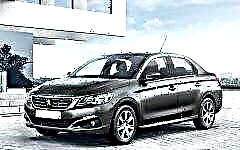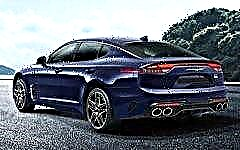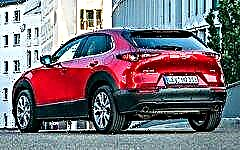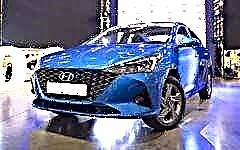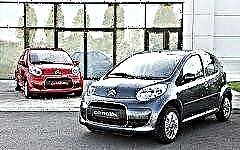

The content of the article:
- 1st generation (2005)
- 2nd generation (2014)
Small car Citroen C1 brings a smile - this nimble kid in a body of various colors was created for women. The modest car easily parks in small spaces, consumes little fuel and is ideal for driving on city roads.
The ideal solution for driving in crowded metropolitan areas are tiny A-class cars, like the Citroen C1, which, despite their small engine, can easily maneuver in the stream and crawl through the narrowness in front of which large cars pass.
They are of little use for long trips, but they cope with daily movements around the city perfectly.
1st generation (2005)

The C1 model is the smallest car of the Citroen family. The subcompact for the city was produced in the form of a three- and five-door hatchback. The car was part of a joint Franco-Japanese project C-Zero, aimed at creating new minicars.
The car was presented at the Geneva auto show in 2005, and a year later, the production of these crumbs began at the Kolín plant in the Czech Republic.
The model has two "twins" from the same project - Toyota Aygo and Peugeot 107, the length of each is no more than 3.4 meters, the capacity is 4 people.
The small cars are outwardly identical, differing only in the front bumper and optics. The C1 design belongs to the Italian Donato Coco, who was also involved in the design of the exterior of other Citroen brainchildren.
In Russia, the official sales of the first generation Citroen began only in 2010, four years after the “conquest of Europe”.
The machine relied on two economical motors. The one-liter gasoline engine consumed 4.6 liters of fuel per hundred kilometers in the combined cycle, and the 1.4-liter diesel four-cylinder power unit "ate" only 4.1 liters of fuel.
After the subsequent restyling, the gasoline engine curbed its appetite, reducing fuel consumption by 0.7 liters. According to the authoritative opinion of Der Spiegel, the car managed to take the second place in terms of economy among mass-produced gasoline cars. Toyota's Prius hybrid came first.
In Russia, the subcompact won the 2012 competition for the title of the most economical car in the country.
A distinctive feature of the appearance of the C1 was the taillights - bright and large. At the five-door, they occupy the entire space from the C-pillar to the rear doors and the trunk lid. The windows on the rear doors are made in the form of a window, without dropping down.
Shortly before entering the Russian car market, Peugeot-Citroen recalled more than one hundred thousand C1 and Peugeot 107 hatchbacks, suggesting the possibility of a defect in the gas pedal, which could cause uncontrolled acceleration.
Despite its seemingly modest appearance, the model served as the basis for all sorts of auto experiments:
- Designer Franco Sbarro created a "hot" concept car, increasing the width of the wheels and wheel arches, modifying the doors to a "gull wing", replacing the engine with a 1.6 liter (126 hp). The brakes had to be applied from the rally version of the C4. As a result, the minicar was accelerated to 210 km / h.
- Portuguese auto repairmen went even further - on the basis of C1 they created a three-door utility vehicle with a diesel engine and the sonorous name of Enterprises.
- Electric Car Corporation from the UK has creatively redesigned the powertrain and since 2009 has been offering the C1 ev'il electric version, which is twice the road of a conventional production car.
Three years after the launch of the car in production, it was decided to subject it to restyling. As a result, the car acquired an updated bumper, decorated with large air intakes.
To make the innovations look serious, they released a special version of the Citroen C1, called Splash. It was equipped with an air conditioning system, power front windows and a CD player. Cars of this modification have acquired a "standard" livery of white with black mirrors and blue with white.
According to the ratings of the British edition BusinessCar, Citroen C1 in 2008 became the best among the city cars. And two years later, in 2010, the ADAC auto club recognized the subcompact (based on statistics on breakdowns for four years) the most reliable in the class of compact cars.
Another restyling was done in 2012, changing the design of the hood and front bumper. The bonnet logo placement and size have changed, and the exterior has been adorned with LED optics and chrome trims.
They also touched on innovations and engines, work on the efficiency of which is a special feature of the C1. The color scheme of the interior has revived, the steering wheel has acquired a new design, and the radio tape recorder has become more modern.

In the photo: 1st generation Citroen C1 dashboard
The three-door hatchback was available in Dynamique and Tendance trims, while the five-door hatchback was available in Exclusive and Tendance trims.
The basic equipment of both versions was the same. The equipment of the machine included halogens, the ability to adjust the steering wheel and electric power, front power windows. Optionally, it was possible to install an air conditioner, foglights, CD-player.
The first EuroNCAP crash test, produced in 2005, placed the car at a "four-star" level, assessing the protection of adults and young passengers as good, but for the safety of pedestrians, only 2 points were awarded.
Similar Toyota Aygo in 2012 was able to "hold out" only up to three "stars" out of five possible.
Citroen C1 differs from all concurrently produced minicars only in style. But the low price, economical robotic transmission made it possible to easily bypass competitors - Chevrolet Spark, Suzuki Splush, Kia Picanto.
Only the Matiz is even cheaper, but it certainly loses in terms of cabin size, poor equipment and poor security.
In Europe, the Citroen C1 has taken root well. In 2009, it was possible to sell 117,000 cars, in 2010 - 105,200. At the same time, in Russia, where citizens often have to travel outside the city, and the roads leave much to be desired, the level of sales is generally low.
In 2010 it was possible to sell 593 cars, in 2010 - 581. But a similar Peugeot 107, thanks to a well-thought-out advertising campaign, is being analyzed much more actively.
2nd generation (2014)

The debut of the second generation Citroen C1 took place in 2014 at the Geneva Motor Show. It was decided to leave production on the territory of the Czech Republic.
Outwardly, the baby looks full of charm: round headlights, lensed optics, a large functional air intake.
The latest versions of the second generation (2018-2019) have a peculiar appearance, the headlights, despite the appearance of "eyes with eyelashes", have a tougher style.
In addition, running lights were installed on the sides of the bumper in small recesses. Sharp lines connecting the optics to the A-pillars give the car a slightly more evil expression.
The windshield did not reach the panoramic one, although some attempt to make it is observed. Heated in the top-end 2018 equipment is available only for windshield wipers.
Optionally, it is proposed to equip the car with a start-up assistance system, keyless access to the salon, a rearview camera, a multimedia system with a 7-inch touchscreen display.
Citroen C1 has a striking design, allowing the owner of the minicar to declare their individuality. The body color in the second generation models pleasantly surprises with a variety, from rich and bright colors to calm "classics".
The basic color of the car is light gray, any other requires an additional payment from 200 to 350 dollars, while you can separately order any color from the catalog for the body and black, menthol or light gray for the roof.

The base engine for the second generation is a three-cylinder gasoline unit for one liter. The small volume limits the possible power of 69 hp, so acceleration to a hundred takes 16 seconds, and the speed ceiling is fixed at 157 km / h.
The advantage of the small volume of the engine was its unconditional efficiency.Citroen C1 consumes 5 liters of fuel for a hundred kilometers of road in the city, and during a quiet “highway” movement, 3.8 liters are enough for it.
A more advanced, top-end power unit is a motor with an increased volume of up to 1.2 liters. The increased volume made it possible to increase the power to 82 hp, allowing the car to acquire much greater dynamics.
Thus, Citroen C1 submits a hundred in 11 seconds, and the permissible speed is fixed at 170 km / h. At the same time, the appetite remains virtually the same as that of the basic “brother” - the urban consumption regime is 5.4 liters, the “highway” mode - 3.7 liters.
The boxes that are offered for the small car are a five-speed "mechanics" or "robot" with variable gears, with a supply of torque to the front axle.
The suspension is pretty typical - MacPherson's in combination with a semi-independent rear beam. The chassis is tough and the braking system is simple, combining drum brakes at the rear with ventilated discs at the front.
Ease of maneuvering is achieved through the installation of an electric power steering and compactness of the car. With a wheelbase of 2,340 mm, the minimum turning headroom is just under 5 meters.
Three- and five-door models are produced, the main highlight of the second generation C1 is the car roof. Various configurations include a solid roof, the ability to install an electric panoramic sunroof, a large panoramic roof, and, most importantly, a folding fabric roof option that turns the hatchback into a convertible.

In the photo: Citroen C1 2nd generation with a retractable roof
The trunk is small, designed for only 196 liters, which is not surprising for an A-class car. With the rear seats folded down, its useful volume is 780 liters.
The simplest configuration of the Citroen C1 contains everything only the most necessary, and the "little things" - a tachometer or air conditioning - are already in the additional options section.
Despite its small size, the interior is quite spacious. The interior trim is made using high quality materials, the placement of the driver and passengers is comfortable, convenient and ergonomic.
The upholstery is supposed to be fabric or leather, the interior can be combined by ordering individual elements and individual upholstery. All control systems and sensors are grouped together, combining compactness and minimalism.
The seats in the new generation Citroen C1 are more sporty, with lateral support and a comfortable fit. The adjustment is carried out using an electric drive or mechanically, there are four adjustment modes in total. Heated front seats.
Despite its still small size and ground clearance of 145 mm, the small car is able to maneuver perfectly, holds the road well, and easily finds parking in a city congested with cars.
The systems responsible for comfort and safety are "sharpened" for city driving. They warn of the occurrence of dangerous situations, control the distance between cars.
According to the results of EuroNCAP testing, the car earned four stars for safety immediately after the release of the second generation.
The minicar owners call the disadvantages a small clearance, which is why it is necessary to install additional protection on the crankcase, and poor noise insulation of the cabin, especially "sounding" at high speed.
Conclusion
There are quite significant differences between the first and second generation Citroen C1. The second generation has become modern, reminiscent of the brand's new cars. Compact on the outside, but spacious on the inside. Equipped with weak engines, the cars are nevertheless nimble, maneuverable and very budgetary.
Citroen





